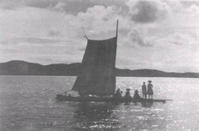


Glimpse of the RAAF Meteorological Service
Preface
Foreword
Introduction
Chapter 1: Growing Up
Chapter 2: Port Moresby Before Pearl Harbour
Sydney to Port Moresby by DH-86
First Impressions of Port Moresby
Meteorological Office Routine
Flight to Kokoda
Tropical Meteorology
John (Doc) Hogan
Setting up House
We Join the RAAF
A Contrast in Attitudes
Some RAAF History
RAAF No 10 Squadron
RAAF No 11 Squadron
The Catalina Story
Construction of the Seven-mile Airstrip and Reclamation Area
Meteorological Service for the RAAF
Unexpected Vistitors
Our State of Readiness
Our Domestic Situation
A Japanese Surprise Packet
What Had We Meteorologists Achieved?
Chapter 3: Port Moresby After Pearl Harbour
Chapter 4: Allied Air Force HQ and RAAF Command, Brisbane
Chapter 5: Japan Surrenders and We Are Demobilised
Epilogue
Acknowledgements
Appendix 1: References
Appendix 2: Milestones
Appendix 3: Papers Published in Tropical Weather Research Bulletins
Appendix 4: Radiosonde Observations 1941–46
Index
Search
Help
Contact us

Setting up House (continued)
As in most equatorial regions the climate of Port Moresby is not aptly described by the conventional terms of spring, summer, autumn and winter. New Guinea seasons are four: south-easterly trade winds from April to October, north-westerly winds from December to February and the oppressive calms or light winds in March and November—the doldrums. Rainfall in New Guinea is largely determined by location relative to the mountainous spine of the island which towers in places to more than 4000m above sea level. Thus hinterlands facing south-east generally have a wet south-east season and those facing north-west a wet north-west season. Inland ranges which rise to over 13,000ft (about 4km) generally have heavy showers in the afternoon throughout the year. In Port Moresby the south-east season is cooler, less humid with low rainfall; the north-west season is warmer, more humid, with more rain, the temperature and humidity relieved to some extent by persistent breezes; the heat and high humidity and lack of breeze during doldrum months make March and November incredibly debilitating for non-acclimatised white people.
Audrey arrived in the middle of the north-west season when the high humidity is tempered by steady north-west winds. She and I were soon introduced to the strong squalls and heavy rain which had the local name of Guba. One dark night we were rudely wakened by the sudden and abrupt onset of torrential rain and gale force winds. Our bedroom windows were glazed and hinged on the side but the living room at the front of the house had shutters hinged at the top and propped open by slender wooden battens. Shutters and windows had been left open and in the gale were violently slamming open and shut. Before we could fasten the windows some were torn from their hinges and crashed to the rocky ground below. The Guba departed as abruptly as it had arrived. We were left somewhat dazed in the darkness caused by the blackout of our electricity supply.
I had written to the head office of the Bureau of Meteorology in Melbourne asking for the installation of a septic tank so that we could have an interior flush toilet to replace the outside pan lavatory. This had not been installed when Audrey arrived and was the first of a series of pioneering inconveniences to which she readily adapted. The primitive powerhouse located near the shore of the harbour provided electricity for lighting only. We had a kerosene refrigerator to preserve our food and a wood-fuel stove to cook it. We ordered provisions (including meat and fresh vegetables) by letter from a Sydney supplier, McIlwraith & Company. This arrived by the Burns Philp ships MV MacDhui or MV Montoro at roughly four weekly intervals. Because the capacity of our refrigerator was very small it was necessary to consume most of our delivery of meat, fresh fruit and vegetables within a day or two. Until the next ship arrived we then reverted to our diet of canned meat and vegetables and powdered milk, relieved only by fruit we bought from the Papuans.
 |
Bureau of Meteorology |  |
© Online Edition Australian Science and Technology Heritage Centre and Bureau of Meteorology 2001
Published by Australian Science and Technology Heritage Centre, using the Web Academic Resource Publisher
http://www.austehc.unimelb.edu.au/fam/0400.html